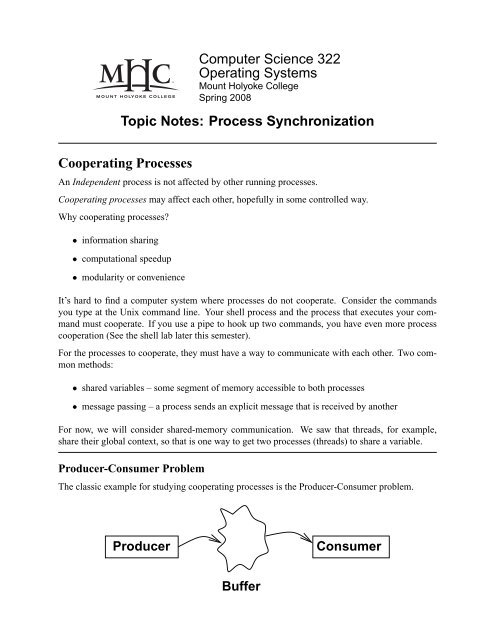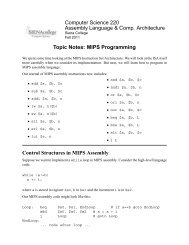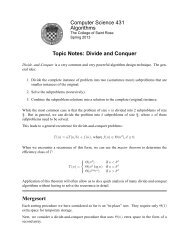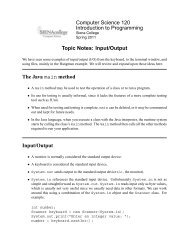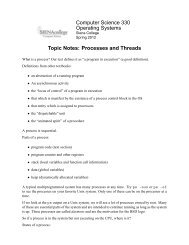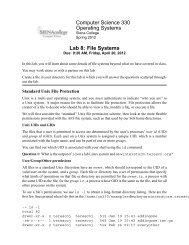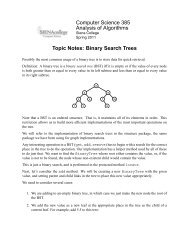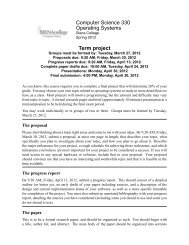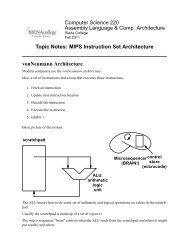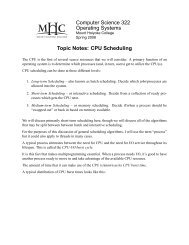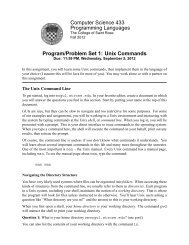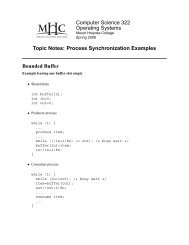Topic Notes: Process Synchronization - Courses
Topic Notes: Process Synchronization - Courses
Topic Notes: Process Synchronization - Courses
Create successful ePaper yourself
Turn your PDF publications into a flip-book with our unique Google optimized e-Paper software.
Computer Science 322Operating SystemsMount Holyoke CollegeSpring 2008<strong>Topic</strong> <strong>Notes</strong>: <strong>Process</strong> <strong>Synchronization</strong>Cooperating <strong>Process</strong>esAn Independent process is not affected by other running processes.Cooperating processes may affect each other, hopefully in some controlled way.Why cooperating processes?• information sharing• computational speedup• modularity or convenienceIt’s hard to find a computer system where processes do not cooperate. Consider the commandsyou type at the Unix command line. Your shell process and the process that executes your commandmust cooperate. If you use a pipe to hook up two commands, you have even more processcooperation (See the shell lab later this semester).For the processes to cooperate, they must have a way to communicate with each other. Two commonmethods:• shared variables – some segment of memory accessible to both processes• message passing – a process sends an explicit message that is received by anotherFor now, we will consider shared-memory communication. We saw that threads, for example,share their global context, so that is one way to get two processes (threads) to share a variable.Producer-Consumer ProblemThe classic example for studying cooperating processes is the Producer-Consumer problem.ProducerConsumerBuffer
CS 322 Operating Systems Spring 2008See Example:/cluster/examples/prodcons-shmemSee Example:/cluster/examples/prodcons-pthreadsIs there any danger with this solution in terms of concurrency? Remember that these processescan be interleaved in any order – the system could preempt the producer at any time and run theconsumer.. Things to be careful about are shared references to variables.Note that only one of the processes can modify the variables in and out. Both use the values,but only the producer modifies in and only the consumer modifies out. Try to come up with asituation that causes incorrect behavior – hopefully you cannot.Perhaps we want to use the entire buffer...let’s add a variable to keep track of how many items arein the buffer, so we can tell the difference between an empty and a full buffer:• Shared dataint buffer[n];int in=0;int out=0;int counter=0;• Producer processwhile (1) {...produce item;...while (counter==n); /* busy wait */buffer[in]=item;in=(in+1)%n;counter=counter+1;}• Consumer processwhile (1) {while (counter==0); /* busy wait */item=buffer[out];out=(out+1)%n;counter=counter-1;...consume item;...}3
CS 322 Operating Systems Spring 2008flag[i] set to true means that P i is requesting access to the critical section.This one also satisties mutual exclusion, but not progress.Both can set their flags, then both start waiting for the other to set flag[j] back to false. Notgoing to happen...If we swap the order of the flag[i]=true; and while (flag[j]); statements, we nolonger satisfy mutual exclusion.Critical Section Algorithm 3We combine the two previous approaches:• Shared dataint turn=0;boolean flag[2];flag[0]=false;flag[1]=false;• <strong>Process</strong> P iwhile (1) {flag[i]=true;turn=j;while (flag[j] && turn==j);}/* critical section */flag[i]=false;/* non-critical section */So, we first indicate interest. Then we set turn=j;, effectively saying “no, you first” to the otherprocess. Even if both processes are interested and both get to the while loop at the “same” time,only one can proceed. Whoever set turn first gets to go first.This one satisfies all three of our conditions. This is known as Peterson’s Algorithm.Peterson’s Algorithm in action:See Example:/cluster/examples/prodcons-pthreadsAlgorithmic Approach for n <strong>Process</strong>es: Bakery algorithm8
CS 322 Operating Systems Spring 2008Can we generalize this for n processes? The Bakery Algorithm (think deli/bakery “now servingcustomer X” systems) does this.The idea is that each process, when it wants to enter the critical section, takes a number. Whoeverhas the smallest number gets to go in. This is more complex than the bakery ticket-spitters becausetwo processes may grab the same number (to guarantee that they wouldn’t would require mutualexclusion – exactly the thing we’re trying to implement), and because there is no attendant to callout the next number – the processes all must come to agreement on who should proceed next intothe critical section.We break ties by allowing the process with the lower process identifier (PID) to proceed. For P i ,we call it i. This assumes PIDs from 0 to n − 1 for n processes, but this can be generalized.Although two processes that try to pick a number at about the same time may get the same number,we do guarantee that once a process with number k is in, all processes choosing numbers will geta number > k.Notation used below: an ordered pair (number, pid) fully identifies a process’ number. Wedefine a lexicographic order of these:• (a,b) < (c,d) is a < c or if a = c and b < dThe algorithm:• Shared data, initialized to 0’s and falseboolean choosing[n];int number[n];• <strong>Process</strong> P iwhile (1) {choosing[i]=true;number[i]=max(number[0],number[i],...,number[n-1])+1;choosing[i]=false;for (j=0; j
CS 322 Operating Systems Spring 2008Before choosing a number, a process indicates that it is doing so. Then it looks at everyone else’snumber and picks a number one larger. Then it says it’s done choosing.Then look at every other process. First, wait for that process not to be choosing. Then make surewe are allowed to go before that process. Once we have successfully decided that it’s safe to gobefore every other process, then go!To leave the CS, just reset the number back to 0.So great, we have a solution. But...problems:1. That’s a lot of code. Lots of while loops and for loops. Could be expensive if we’re going todo this a lot.2. If this is a highly popular critical section, the numbers might never reset, and we couldoverflow our integers. Unlikely, but think what could happen if we did.3. It’s kind of inconvenient and in some circumstances, unreasonable, to have these arrays of nvalues. There may not always be n processes, as some may come and go.<strong>Synchronization</strong> hardwareHardware support can make some of this a little easier. Problems can arise when a process ispreempted within a single high-level language line. But we can’t preempt in the middle of amachine instruction.If we have a single machine instruction that checks the value of a variable and sets it atomically,we can use that to our advantage.This is often called a Test-and-Set or Test and Set Lock instruction, and does this, atomically:boolean TestAndSet(boolean *target) {boolean orig_val = *target;*target = TRUE;return orig_val;}So it sets the variable passed in to true, and tells us if it was true or false before we called it. So iftwo processes do this operation, both will set the value of target to true, but only one will get areturn value of false.This is the functionality we want, but how does the instruction actually work?Really, this would be an instruction that takes two operands:TAS R, X10
CS 322 Operating Systems Spring 2008Where R is a CPU register and X is a memory location. After the instruction completes (atomically),the value that was in memory at X is copied into R, and the value of X is set to 1. R containsa 0 if X previously contained a 0. If two processes do this operation concurrently, only one willactually get the 0.The Intel x86 BTS instruction sets a single bit in memory and sets the carry bit of the status wordto the previous value. This is equivalent.Think about how you might implement an atomic test and set on, for example, a microprogrammedarchitecture.Any of these can be used to implement a “test and set” function as described above.Armed with this atomic test-and-set, we can make a simple mutual exclution solution for anynumber of processes, with just a single shared variable:• Shared databoolean lock = false;• <strong>Process</strong> P iwhile (1) {while (TestAndSet(&lock)); /* busy wait *//* critical section */lock = false;}/* non-critical section */This satisfies mutual exclusion and progress, but not bounded waiting (a process can leave the CSand come back around and grab the lock again before others who may be waiting ever get a chanceto look).A solution that does satisfy bounded waiting is still fairly complicated:• Shared databoolean lock=false;boolean waiting[n]; /* all initialized to false */• <strong>Process</strong> P i and its local data11
CS 322 Operating Systems Spring 2008int j;boolean key;while (1) {waiting[i]=true;key=true;while (waiting[i] && key)key = TestAndSet(&lock);waiting[i]=false;}/* critical section */j=(i+1)%n;while ((j!=i) && !waiting[j])j=(j+1)%n;if (j==i) lock=false;else waiting[j]=false;/* non-critical section */Another hardware instruction that might be available is the atomic swap operation:void swap(boolean *a, boolean *b) {boolean temp = *a;*a = *b;*b = temp;}Different architectures have variations on this one, including the x86 XCHG instruction.An algorithm to use this, minus the bounded wait again, is straightforward:• Shared databoolean lock = false;• <strong>Process</strong> P iboolean key = true;while (1) {while (key == true) swap(&key,&lock); /* busy wait */12
CS 322 Operating Systems Spring 2008/* critical section */lock = false;}/* non-critical section */It’s pretty similar to what we saw before with TestAndSet().SemaphoresAll that busy waiting in all of our algorithms for mutual exclusion is pretty annoying. It’s justwasted time on the CPU. If we have just one CPU, it doesn’t make sense for that process to takeup its whole quantum spinning away waiting for a shared variable to change that can’t change untilthe current process relinquishes the CPU!This inspired the development of the semaphore. The name comes from old-style railroad trafficcontrol signals (see http://www.semaphores.com), where mechanical arms swing down toblock a train from a section of track that another train is currently using. When the track was free,the arm would swing up, and the waiting train could now proceed.A semaphore S is basically an integer variable, with two atomic operations:wait(S):while (S
CS 322 Operating Systems Spring 2008provide semaphores through system calls. We will examine their implementation in this contextsoon.Given semaphores, we can create a much simpler solution to the critical section problem for nprocesses:• Shared datasemaphore mutex=1;• <strong>Process</strong> P iwhile (1) {wait(mutex);/* critical section */signal(mutex);}/* non-critical section */The semaphore provides the mutual exclusion for sure, and should satify progress, but dependingon the implementation of semaphores, may or may not provide bounded waiting.A semaphore implementation might look like this:struct semaphore {int value;proclist L;};• block operation suspends the calling process, removes it from consideration by the scheduler• wakeup(P) resumes execution of suspended process P , puts it back into consideration• wait(S):S.value--;if (S.value < 0) {add this process to S.L;block;}14
CS 322 Operating Systems Spring 2008• signal(S):S.value++;if (S.value
CS 322 Operating Systems Spring 2008Here, P j will be forced to wait only if it arrives at the wait call before P i has executed thesignal.Of course, we can introduce deadlocks (two or more processes waiting indefinitely for an eventthat can only be caused by one of the waiting processes).Consider semaphores Q and R, initialized to 1, and two processes that need to wait on both. Acareless programmer could write:Things might be fine, but they might not be.P 0 P 1wait(Q); wait(R);wait(R); wait(Q);... ...signal(R); signal(Q);signal(Q); signal(R);... ...There’s also the possibility that a process might just forget a signal and leave one or more otherprocesses (maybe even itself) waiting indefinitely.We will look into the implementation of semaphores and mutexes later, but for now we will lookmore at how to use them as a synchronization tool.Classical Problems of <strong>Synchronization</strong>We will use semaphores to consider some synchronization problems. While some actual implementationsprovide the ability to “try to wait”, or to examine the value of a semaphore’s counter,we restict ourselves to initialization, wait, and signal.Bounded buffer using semaphoresFirst, we revisit our friend the bounded buffer.• Shared data:semaphore fullslots, emptyslots, mutex;full=0; empty=n; mutex=1;• Producer process:while (1) {produce item;wait(emptyslots);16
CS 322 Operating Systems Spring 2008}wait(mutex);add item to buffer;signal(mutex);signal(fullslots);• Consumer process:while (1) {wait(fullslots);wait(mutex);remove item from buffer;signal(mutex);signal(emptyslots);consume item;}mutex provides mutual exclusion for the modification of the buffer (not shown in detail). Theothers make sure that the consumer doesn’t try to remove from an empty buffer (fullslots is> 0) or that the producer doesn’t try to add to a full buffer (emptyslots is > 0).Dining Philsophers• One way to tell a computer scientist from other people is to ask about the dining philosophers.• Five philosophers alternate thinking and eating• Need 2 forks to do so (eating spaghetti), one from each side• keep both forks until done eating, then replace bothSince fork is the name of a C function, we’ll use a different (and possibly more appropriate)analogy of chopsticks. The philosophers needs two chopsticks to eat rice.• Shared data:semaphore chopstick[5];chopstick[0..4]=1;• Philosopher i:17
CS 322 Operating Systems Spring 2008while (1) {wait(chopstick[i]);wait(chopstick[(i+1)%5]);}/* eat */signal(chopstick[i]);signal(chopstick[(i+1)%5]);/* think */This solution may deadlock.One way to reduce the chances of deadlock might be to think first, since each might think for adifferent amount of time.Another possibility:Each philosopher1. Picks up their left chopstick2. Checks to see if the right chopstick is in use3. If so, the philosopher puts down their left chopstick, and starts over at 1.4. Otherwise, the philosopher eats.Does this work?No! It livelocks. Consider this: all could pick up their left chopstick, look right, put down the left,and repeat indefinitely.How to solve this? Must either1. introduce an asymmetry, or2. limit the number of concurrently hungry philosophers to n − 1.Here’s one that includes an asymmetry, by having odd numbered philosophers pick up to the rightfirst. The code for philosopher i and problem size n.void philosopher() {think;if (odd(i)) {18
CS 322 Operating Systems Spring 2008}wait(chopstick[(i+1) % n]);wait(chopstick[i]);}else {wait(chopstick[i]);wait(chopstick[(i+1) % n]);}eat;if (odd(i)) {signal(chopstick[(i+1) % n]);signal(chopstick[i]);}else {signal(chopstick[i]);signal(chopstick[(i+1) % n]);}Readers-WritersWe have a database and a number of processes that need access to it. We would like to maximizeconcurrency.• There are multiple “reader processes” and multiple “writer processes”.• Readers see what’s there, but don’t change anything. Like a person on a travel web siteseeing what flights have seats available.• Writers change the database. The act of making the actual reservation.• It’s bad to have a writer in with any other writers or readers – may sell the same seat to anumber of people (airline, sporting event, etc). Remember counter++ and counter--!• Multiple readers are safe, and in fact we want to allow as much concurrent access to readersas we can. Don’t want to keep potential customers waiting.A possible solution:• Shared data:semaphore wrt, mutex;int readcount;wrt=1; mutex=1; readcount=0;• Writer process:19
CS 322 Operating Systems Spring 2008while (1) {wait(wrt);/* perform writing */}signal(wrt);• Reader process:while (1) {wait(mutex);readcount++;if (readcount == 1) wait(wrt);signal(mutex);/* perform reading */}wait(mutex);readcount--;if (readcount == 0) signal(wrt);signal(mutex);Note that the semaphore mutex protects readcount and is shared among readers only.Semaphore wrt is indicates whether it is safe for a writer, or the first reader, to enter.Danger: a reader may wait(wrt) while inside mutual exclusion of mutex. Is this OK?This is a reader-preference solution. Writers can starve! This might not be good if the readers are“browsing customers” but the writers are “paying customers!”Sleeping BarberProblem: A certain barber shop has a single barber, a barber’s chair, and n chairs in a waiting area.The barber spends his life in the shop. If there are no customers in the shop, the barber sleeps inthe chair until a customer enters and wakes him. When customers are in the shop, the barber isgiving one a haircut, and will call for the next customer when he finishes with each. Customersarrive periodically. If the shop is empty and the barber is asleep in the barber’s chair, he wakes thebarber and gets a haircut. If the barber is busy, but there are chairs available in the waiting room,he sleeps in one of those chairs until called. Finally, if there are no available chairs in the waitingroom, the customer leaves and comes back another time.A possible solution:• Shared Data20
CS 322 Operating Systems Spring 2008constant CHAIRS = maximum number of chairs (including barber chair)semaphore mutex=1,next_cust=0,barber_ready=0;int cust_count=0;• Customer processwhile (1) {/* live your non barber-shop life until you decide you needa haircut */wait(mutex);if (cust_count>=CHAIRS) {signal(mutex);exit; /* leave the shop if full, try tomorrow */}cust_count++; /* increment customer count */signal(mutex);signal(next_cust); /* wake the barber if he’s sleeping */wait(barber_ready); /* wait in the waiting room *//* get haircut here */}wait(mutex);cust_count--; /* leave the shop, freeing a chair */signal(mutex);• Barber processwhile (1) {wait(next_cust); /* sleep until a customer shows up */signal(barber_ready); /* tell the next customer you are ready */}/* give the haircut here */Semaphore ImplementationsPOSIX semaphoresWe have seen examples using POSIX semaphores and pthread mutexes.POSIX semaphores are implemented using pthreads mutexes:21
CS 322 Operating Systems Spring 2008/usr/src/lib/libc r/uthread/uthread sem.cThe struct sem definition is in /usr/src/lib/libc r/uthread/pthread private.hThis is an implementation of full counting semaphores using a construct that is much like a binarysemaphore.Note that if we determine that a wait() call must result in an actual wait (rather than just adecrement of the semaphore value) we need to put the thread to sleep and unlock the mutex.We need something else to “sleep” on. All we have to work with are pthread functions here, notthe actual kernel data structures that a lower-level implementation of semaphores might use.pthreads provides a construct called a condition variable, with which a thread can be put to sleepwith a call to pthread cond wait().This essentially provides a place for pthreads to sleep awaiting someone to “signal” them by callingpthread cond signal().Calling pthread cond wait() also releases the mutex so some other thread can have thechance to come in and do a sem post() to let us continue at some point in the future.The thread automatically reacquires the mutex lock when it is awakened.We can see the calls to pthread cond wait() in sem wait() and pthread cond signal()in sem post().This implementation also provides a sem trywait() and a sem getvalue() which makethese even more flexible than the semaphores we have been assuming for our synchronizationproblems.Note: in FreeBSD, these are implemented as an extention to the pthreads library, and cannot beused for synchronization of independent processes. (see the comment in sem init())Pthreads mutex/condition variablesBut what about these pthread mutexes and condition variables? How are these achieved?See /usr/src/lib/libc r/uthread/pthread private.h, /usr/src/lib/libcr/uthread/uthread mutex.c and /usr/src/lib/libc r/uthread/uthread cond.c.First, note the structure definitions for struct pthread mutex and struct pthread cond.The pthread mutex init() function initializes the structure. Not much of interest here.The pthread mutex lock() just calls another internal routine, mutex lock common().Once we check errors and defer signals, we call_SPINLOCK(&(*mutex)->lock);22
CS 322 Operating Systems Spring 2008As the name suggests, this is a spin lock. But aren’t we supposed to be avoiding these? Let’s seewhat this is all about. It is a macro. It actually ends up calling a function spinlock defined in/usr/src/lib/libc r/uthread/uthread spinlock.cWhile we cannot obtain the lock with an atomic test and set operation, we yield the CPU and tryagain. Note that the atomic test operation, defined in /usr/src/lib/libc r/arch/i386/atomic lock.S, uses the xchg instruction on the x86. This instruction is an atomic swapof the value in a register with the values in a memory location. Note that each architecture hassomething implemented in assembly that will provide equivalent functionality.OK, so back in the mutex lock common() function, we have exclusive access to the mutexdata structure. We can now see if it’s locked (if it has a non-NULL owner). If not, we take it. If so,we add ourself to the list of waiters. The thread kern sched state unlock() functionthen unlocks the mutex, and we change our state to PS MUTEX WAIT, so we will not be scheduleduntil the mutex is unlocked.When it comes time to unlock, we end up in the mutex unlock common() function. Webasically get the lock on the mutex (spinlock). If there are threads waiting on the lock, we pick thenext one, set its state to PS RUNNING and do some other bookkeeping so it can run. If no threadwas waiting, the assignment inside the if statement sets the owner to NULL, unlocking the mutexfor the next lock attempt.So what about the condition variable?This is implemented in /usr/src/lib/libc r/uthread/uthread cond.c.Initialization is straightforward - not much of interest here.pthread cond wait() is where the interesting functionality lives. Once we see that the callis valid, the current thread is added to the condition variable’s waiting queue, and given a “neverwake up” status, set its state to PS COND WAIT.pthread cond signal() selects a thread that is waiting on the condition variable and wakesit up by setting its state to PS RUNNING.SysV SemaphoresFreeBSD also implements System V semaphores.SysV (along with BSD) was one of the two major “flavors” of Unix.Most Unix systems were either BSD-based (SunOS up to 4.x, Ultrix) or SysV-based (Irix, Solaris).Despite being (as you may have guessed) BSD-based, FreeBSD relies on a semaphore implementationfrom a long, long time ago from SysV.These are described in great detail in Bach.They are allocated in groups, stored in arrays.See Example:/cluster/examples/prodcons-sysvsemaphore23
CS 322 Operating Systems Spring 2008This example demonstrates the use of these semaphores to synchronize independent processes.The buffer process creates and initializes the semaphores (and some shared memory). Semaphorescreated with semget(), we set their initial values by calling semctl() with the SETVAL command.Producer and consumer processes attach to the existing shared memory and semaphores, then usethe semaphores as we have seen in producer/consumer examples in class. Using semop() call.We won’t look at the implementation of these in as much detail as we did for the POSIX semaphores,but here are some highlights.Implementation for FreeBSD is in /usr/src/sys/kern/sysv sem.cSee semop() calling msleep() (Line 1052).msleep() is a kernel call that puts a process to sleep until someone calls wakeup().These are defined in /usr/src/sys/kern/kern synch.c and this is where PCBs are actuallyput into sleep queues and removed from ready/run queues.Windows XP SemaphoresWindows XP provides both binary semaphores (mutexes) and counting semaphores.MonitorsSemaphores are error-prone (oops, did I say wait? I meant signal!). You might never releasea mutex, might run into unexpected orderings that lead to deadlock.Monitors are a high-level language constuct intended to avoid some of these problems. A monitoris an abstract data type with shared variables and methods, similar to a C++ or Java class.monitor example_mon {shared variables;procedure P1(...) {...}procedure P2(...) {...}...}initialization/constructor;24
CS 322 Operating Systems Spring 2008A monitor has a special property that at most one process can be actively executing in its methodsat any time. Mutual exclusion everywhere inside the monitor!But if only one process can be in, and a process needs to wait, no other processes can get in.So an additional feature of monitors is the condition variable. This is a shared variable that hassemaphore-like operations wait() and signal(). When a process in a monitor has to wait ona condition variable, other processes are allowed in.But when happens on a signal? If we just wake up the waiting process and let the signalling processcontinue, we have violated our monitor’s rules and have two active processes in the monitor. Twopossibilities:• Force the signaler to leave immediately• Force the signaler to wait until the awakened waiter leavesThere are waiting queues associated with each condition variable, and with the entire monitor forprocesses outside waiting for initial entry.Note that monitors are a language construct. They can be implemented using OS-provided functionalitysuch as semaphores.Also note the similarity between these monitors and Java classes and methods that use the synchronizedkeyword.25


